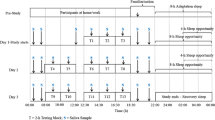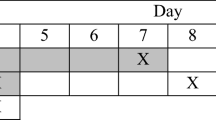Abstract
Purpose
To examine the effects of sleep restriction on firefighters’ physical task performance, physical activity, and physiological and perceived exertion during simulated hot wildfire conditions.
Methods
31 firefighters were randomly allocated to either the hot (n = 18, HOT; 33 °C, 8-h sleep opportunity) or hot and sleep restricted (n = 13, HOT + SR; 33 °C, 4-h sleep opportunity) condition. Intermittent, self-paced work circuits of six firefighting tasks were performed for 3 days. Firefighters self-reported ratings of perceived exertion. Heart rate, core temperature, and physical activity were measured continuously. Fluids were consumed ad libitum, and all food and fluids consumed were recorded. Urine volume and urine specific gravity (USG) were analysed and sleep was assessed using polysomnography (PSG).
Results
There were no differences between the HOT and HOT + SR groups in firefighters’ physical task performance, heart rate, core temperature, USG, or fluid intake. Ratings of perceived exertion were higher (p < 0.05) in the HOT + SR group for two of the six firefighting tasks. The HOT group spent approximately 7 min more undertaking moderate physical activity throughout the 2-h work circuits compared to the HOT + SR group.
Conclusion
Two nights of sleep restriction did not influence firefighters’ physical task performance or physiological responses during 3 days of simulated wildfire suppression. Further research is needed to explore firefighters’ pacing strategies during real wildfire suppression.

Similar content being viewed by others
References
Aisbett B, Wolkow A, Sprajcer M, Ferguson SA (2012) Awake, smoky, and hot: providing an evidence-base for managing the risks associated with occupational stressors encountered by wildland firefighters. Appl Ergon 43:916–925. https://doi.org/10.1016/j.apergo.2011.12.013
American College of Sports Medicine (2010) ACSM’s guidelines for exercise testing and prescription. 8th edn edn. Wolters Kluwer, Lippincott Williams & Wilkins, Philadelphia
Borg G (1982) Psychophysical bases of perceived exertion. Med Sci Sports Exerc 14:377–381
Cater H, Clancy D, Duffy K, Holgate A, Wilison B, Wood J (2007) Fatigue on the fireground: the DPI Experience. In: Thornton R (ed) Australasian Fire Authorities Council and Bushfire Co-Operative Research Centre Annual Conference, Hobart, Tasmania, Australia, pp 19–21
Cvirn M, Smith B, Jay S, Vincent C, Ferguson S (2015) The impact of temperature on the sleep characteristics of volunteer firefighters during a wildland fireground tour simulation. In: 14th Annual Scientific Meeting of the Australasian Chronobiology conference proceedings, pp 18–24
Cvirn MA, Dorrian J, Smith BP, Jay SM, Vincent GE, Ferguson SA (2017) The sleep architecture of Australian volunteer firefighters during a multi-day simulated wildfire suppression: impact of sleep restriction and temperature. Accid Anal Prev 99:389–394
Dawson D, Chapman J, Thomas MJW (2011) Fatigue-proofing: a new approach to reducing fatigue-related risk using the principles of error management. Sleep Med Rev 16:167–175
Dewasmes G, Bothorel B, Hoeft A, Candas V (1993) Regulation of local sweating in sleep-deprived exercising humans. Eur J Appl Physiol Occup Physiol 66:542–546
Fullagar HH, Skorski S, Duffield R, Hammes D, Coutts AJ, Meyer T (2014) Sleep and athletic performance: the effects of sleep loss on exercise performance, and physiological and cognitive responses to exercise. Sports Med 45:1–26
Gellish R, Gosliin B, Olson R, McDonald A, Russi G, Moudgil V (2007) Longitudinal modeling of the relationship between age and maximal heart rate. Med Sci Sports Exerc 39:822–829
Gomersall SR, Rowlands AV, English C, Maher C, Olds TS (2013) The ActivityStat Hypothesis. Sports Med 43:135–149
Kolka MA, Stephenson LA (1988) Exercise thermoregulation after prolonged wakefulness. J Appl Physiol 64:1575–1579
Lander PJ, Butterly RJ, Edwards AM (2009) Self-paced exercise is less physically challenging than enforced constant pace exercise of the same intensity: influence of complex central metabolic control. Br J Sports Med 43:789–795
Larsen B, Snow R, Vincent G, Tran J, Wolkow A, Aisbett B (2015) Multiple days of heat exposure on firefighters’ work performance and physiology. PloS One 10:e0136413. https://doi.org/10.1371/journal.pone.0136413
Lee Y-A, Hyun K-J, Tokura H (2001) Circadian rhythms of core body temperature and urinary noradrenaline secretion under the influence of skin pressure due to foundation garments worn during wakefulness. Biol Rhythm Res 32:389–400
Liu Y, Stanturf J, Goodrick S (2010) Trends in global wildfire potential in a changing climate. For Ecol Manag 259:685–697. https://doi.org/10.1016/j.foreco.2009.09.002
Martin BJ (1981) Effect of sleep deprivation on tolerance of prolonged exercise. Eur J Appl Physiol Occup Physiol 47:345–354
Molenberghs G, Verbeke G (2001) A review on linear mixed models for longitudinal data possibly subject to dropout. Stat Model 1:235–269
Moore JP, Harper Smith AD, Di Felice U, Walsh NP (2013) Three nights of sleep deprivation does not alter thermal strain during exercise in the heat. Eur J Appl Physiol 113:2353–2360. https://doi.org/10.1007/s00421-013-2671-2
Phillips M, Payne W, Lord C, Netto K, Nichols D, Aisbett B (2012) Identification of physically demanding tasks performed during bushfire suppression by Australian rural firefighters. Appl Ergon 43:435–441. https://doi.org/10.1016/j.apergo.2011.06.018
Pilcher JJ, Vander Wood MA, O’Connell KL (2011) The effects of extended work under sleep deprivation conditions on team-based performance. Ergonomics 54:587–596
Plyley MJ, Shephard RJ, Davis GM, Goode RC (1987) Sleep deprivation and cardiorespiratory function. Influence of intermittent submaximal exercise. Eur J Appl Physiol Occup Physiol 56:338–344
Rabe-Hesketh S, Skrondal A, Pickles A (2002) Reliable estimation of generalized linear mixed models using adaptive quadrature. Stata J 2:1–21
Raines J, Snow R, Petersen A, Harvey J, Nichols D, Aisbett B (2012) Pre-shift fluid intake: effect on physiology, work and drinking during emergency wildfire fighting. Appl Ergon 43:532–540. https://doi.org/10.1016/j.apergo.2011.08.007
Raines J, Snow R, Nichols D, Aisbett B (2015) Fluid intake, hydration, work physiology of wildfire fighters working in the heat over consecutive days. Ann Occup Hyg 59(5):554–565
Rodgers C, Paterson D, Cunningham D, Noble E, Pettigrew F, Myles W, Taylor A (1995) Sleep deprivation: effects on work capacity, self-paced walking contractile properties perceived exertion. Sleep 18:30–38
Rodríguez-Marroyo J, López-Satue J, Pernía R, Carballo B, García-López J, Foster C, Villa J (2012) Physiological work demands of Spanish wildland firefighters during wildfire suppression. Int Arch Occup Environ Health 85:221–228. https://doi.org/10.1007/s00420-011-0661-4
Sawka MN, Burke LM, Eichner ER, Maughan RJ, Montain SJ, Stachenfeld NS (2007) American College of sports medicine position stand exercise fluid replacement. Med Sci Sports Exerc 39:377–390
Singer JD (1998) Using SAS PROC MIXED to fit multilevel models, hierarchical models, and individual growth models. J Educ Behav Stat 23:323–355
Smith D, Petruzzello S, Kramer J, Misner J (1997) The effects of different thermal environments on the physiological and psychological responses of firefighters to a training drill. Ergonomics 40:500–510
Van Dongen HPA, Maislin G, Mullington JM, Dinges DF (2003) The cumulative cost of additional wakefulness: dose-response effects on neurobehavioral functions and sleep physiology from chronic sleep restriction and total sleep deprivation. Sleep 26:117–129
Vincent G, Ferguson SA, Tran J, Larsen B, Wolkow A, Aisbett B (2015) Sleep restriction during simulated wildfire suppression: effect on physical task performance. PloS One 10:e0115329. https://doi.org/10.1371/journal.pone.0115329
Vincent GE, Aisbett B, Hall SJ, Ferguson SA (2016a) Fighting fire and fatigue: sleep quantity and quality during multiday wildfire suppression. Ergonomics 59:932–940
Vincent GE, Ridgers ND, Ferguson SA, Aisbett B (2016b) Associations between firefighters’ physical activity across multiple shifts of wildfire suppression. Ergonomics 59:924–931
Vincent GE, Aisbett B, Hall SJ, Ferguson SA (2016c) Sleep quantity and quality is not compromised during planned burn shifts of less than 12 h. Chronobiol Int 33(6):657–666
Vincent GE, Aisbett B, Larsen B, Ridgers ND, Snow R, Ferguson SA (2017) The impact of heat exposure and sleep restriction on firefighters’ work performance and physiology during simulated wildfire suppression. Int J Environ Res Public Health 14:180
Wolkow A, Ferguson SA, Vincent GE, Larsen B, Aisbett B, Main LC (2015) The impact of sleep restriction and simulated physical firefighting work on acute inflammatory stress responses. PLoS One 10:e0138128. https://doi.org/10.1371/journal.pone.0138128
Young AJ, Sawka MN, Epstein Y, DeCristofano B, Pandolf KB (1987) Cooling different body surfaces during upper and lower body exercise. J Appl Physiol 63:1218–1223
Acknowledgements
We would like to acknowledge the Bushfire Co-operative Research Centre for providing logistical support for this project. We would like to thank all the firefighters that generously volunteered their time to participate in this research. Dr. Grace Vincent is supported by an Early Career Fellowship at Central Queensland University. Dr. Nicola D Ridgers was supported by an Australian Research Council Discovery Early Career Researcher Award (DE120101173). We acknowledge Eoin O’Connell for the development of the customized Excel macro and Dr. Jacqueline Tran for assistance with the statistical analyses.
Funding
This study was funded by the Bushfire Co-operative Research Centre (Grant name: Operational readiness of rural firefighters during bushfire suppression).
Author information
Authors and Affiliations
Corresponding author
Ethics declarations
Research involving human participants
All procedures performed in studies involving human participants were in accordance with the ethical standards of the institutional and/or national research committee and with the 1964 Helsinki declaration and its later amendments or comparable ethical standards.
Informed consent
Informed consent was obtained from all individual participants included in the study.
Conflict of interest
The authors declare they have no conflicts of interest.
Rights and permissions
About this article
Cite this article
Vincent, G.E., Ferguson, S., Larsen, B. et al. Adding sleep restriction to the equation: impact on wildland firefighters’ work performance and physiology in hot conditions. Int Arch Occup Environ Health 91, 601–611 (2018). https://doi.org/10.1007/s00420-018-1304-9
Received:
Accepted:
Published:
Issue Date:
DOI: https://doi.org/10.1007/s00420-018-1304-9




